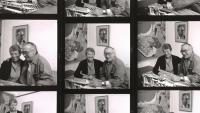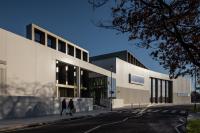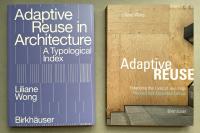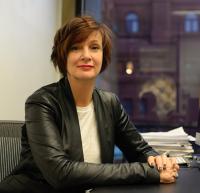Austrian Pavilion EXPO 2025 Osaka
Osaka, Japan
The World Expo – “Expo 2025” – is held in Osaka from 13 April to 13 October 2025. BWM Designers & Architects, in collaboration with facts and fiction, won the two-stage realisation competition for the design of the Austrian pavilion. The concept is a musical interpretation of the Expo’s motto – „Designing Future Society for Our Lives“. The idea is that, in Austria, the future is not „designed“, but rather composed: „Austria. Composing the Future“.
The Austria Pavilion comprises two main elements: the monumental spiral sculpture in the forecourt and the functional pavilion building housing the exhibition space, behind the spiral.
The pavilion’s storyline: Composing the Future
An iconic spiral sculpture rises dramatically into the air, serving as the visual centrepiece of the Austria Pavilion at the World Expo. Viewed up close, it reveals itself as an oversized wooden musical staff featuring the opening bars of the Ode to Joy. The spiral holds a universal symbolic power that transcends cultures. It invites reflection on the cyclical nature of life, on change, growth and transformation – beyond linear models of progress.
Especially in light of global challenges and increasing anxiety about the future, Austria’s soaring spiral stands as a powerful symbol of joy and optimism. The shape of the spiral is inspired by music – something Austria is especially well known for in Japan. Music brings movement: a twirling waltz, a conductor’s gestures, the rhythm of dance – all of these things are expressed in the spiral. The reverse side of the spiral is designed as a musical staff that rises ever upwards. The opening bars of the Ode to Joy stand for the deep emotional power of music – a force that resonates across cultures and borders.
Beyond that, the choice of this melody is also a cultural statement: as the anthem of the European Union, it reflects Austria’s transnational identity. Austria sees itself as part of a larger whole, where music – as a universal language – builds bridges and brings people together across borders. Beethoven, the composer of this iconic piece, was born in Germany and wrote his works in Austria. And yet, his music doesn’t belong to any one nation, but to the world as a whole.
Composing the Future – a joyful, collective endeavour.
The spiral.
The standout feature of the Austria Pavilion is an eye-catching spiral sculpture that stretches up to the sky. Made of wood, it showcases Austria’s expertise in modern timber construction and highlights how this traditional material is making a big comeback as a sustainable alternative in light of the global shift towards minimising CO₂ emissions. Wood bridges tradition and innovation in a unique way.
The 91m-long, 4.3m-wide “ribbon” consists of an upper and a lower edge that are interlaced with 265 diagonal struts. The double-looped form is supported by five steel pylons and rises to a height of 16m. The inner surface of the spiral is designed as a musical staff, featuring the opening bars of Beethoven’s Ode to Joy. On the outside, the bare timber construction is on full display – complete with all its joints and structural details.
The wooden spiral was built by an Austrian company based in Horn (Lower Austria). It was then taken apart and the segments shipped in ten containers. After arriving in Japan, the structure was assembled with great precision by a local timber construction firm – a prime example of a successful collaboration between Austrian and Japanese timber construction experts.
The execution of this monumental sculpture was technically demanding and required state-of-the-art planning, calculation and manufacturing methods. One of the unique features is the construction method using screwed wooden slats made from certified Austrian spruce. Thanks to the principle of “screwing instead of gluing”, the entire structure is completely demountable and reusable, which allows for the sustainable use of the materials beyond Expo 2025
The pavilion building.
The pavilion building, which connects directly to the wooden spiral, was constructed as a functional modular steel structure. It can be easily disassembled into its constituent parts and reused after the Expo. Covering a footprint of 490m², the single-storey exhibition hall is divided into three spaces, the third of which, with a height of 11m, contains an immersive multimedia installation that marks the grand finale of the experience.
The first floor houses offices and a VIP lounge. On the second floor, a café with seating for up to 50 guests offers a place to unwind and space for events. Visitors access this area via a striking staircase that is integrated into the wooden sculpture and that continues up all the way to the fourth floor, culminating in an observation deck.
The forecourt in front of the pavilion features a welcome kiosk, a little shop and a culinary treat: freshly made takeaway Kaiserschmarrn. Visitors can enjoy a little piece of Austrian food culture as they wander the Expo grounds.
Why is the spiral made of wood?
Besides music, Austria and Japan are united in their deep appreciation for traditional craftsmanship – particularly in timber construction. As a building material, wood is both classic and highly modern and forward-looking. Given the increasing need to reduce CO₂-intensive construction methods, wood plays an ever-growing role. Austria boasts exceptional expertise in this area and is recognised as a global leader in modern engineered timber construction. The spiral sculpture embodies the excellence of Austrian timber craftsmanship while also serving as a prime example of sustainable architecture. The soaring structure seems to defy gravity, giving the impression that the material is flying …
The exhibition.
The exhibition inside the pavilion is spread across three rooms. In the first space, the music staff comes to life and turns into a projection surface. Here, visitors experience the richness of the relationship between Austria and Japan in a captivating musical opening. From there, they move on to oversized interactive notes, where they can playfully explore the diversity and strengths of Austria’s economic and societal landscape. The final room marks the highlight of the exhibition: the Cathedral of the Future. In this space, visitors engage interactively with the future and are invited to participate in composing it – in line with the motto ‘Composing the Future’.
Conclusion: Austria’s offering at Expo 2025 – Designing Future Society for Our Lives "COMPOSING THE FUTURE"
1. Symbol: Optimism and hope. The spiral sends a strong message of optimism and joy – a symbol that speaks to movement, change and progress across all cultures.Music: Connection and inspiration
2. Music: Connection and inspiration. Much like dynamics in music, the spiral rises ever upward. Music knows no borders and unites people – just as Austria sees itself as a bridge between cultures.Wood: Building for the future
3. Wood: Building for the future. As a material rooted in tradition yet firmly geared toward the future, wood stands for sustainable construction and the mindful use of resources. The spiral exemplifies Austria’s leading role in state-of-the-art timber construction.
- Architects
- BWM Designers & Architects
- Location
- Osaka, Japan
- Year
- 2025
- Client
- Bundesministerium für Arbeit und Wirtschaft, Wirtschaftskammer Österreich, EXPO-Büro Wirtschaftskammer Österreich (Alf Netek
- Team
- Johann Moser, Hubert Meyer, Kinga Baluch, Clemens-Veit Hörl, Mihael Barada, Konrad Rautter
- Konzeption und Gestaltung der Ausstellung
- BWM Designers & Architects in Zusammenarbeit mit facts and fiction
- Statik
- Werkraum Ingenieure ZT GmbH
- Haustechnikplanung
- Energytech G.m.b.H.
- Bauphysik
- K2 Bauphysik GmbH
- Landschaftsplanung
- PAISAGISTA Landschaftsplanung
- Projektmanagement
- Werner Consult Ziviltechnikergmbh
- Generalübernehmer
- Nüssli Gruppe












